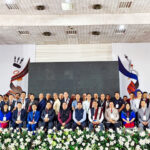The Eastern Naga Students’ Federation (ENSF) recently issued a statement explaining their reasons for the demand of Frontier Nagaland Territory. They highlighted significant disparities between Eastern Nagaland and the rest of the state, citing the region’s per capita income, which stands at around Rs 5,000 compared to Rs 16,000 in the rest of Nagaland.
Furthermore, the ENSF emphasized the employment statistics, revealing that only 18% of Eastern Nagaland’s population is employed, compared to 82% in the rest of the state, despite the implementation of the Reservation Policy.
Moreover, the federation pointed out historical grievances regarding political representation. At the time of Nagaland State creation, although Eastern Nagaland comprised 48% of the total population, it had only six MLAs representing the region, while the Naga Hills Area had 40 members in the Nagaland Assembly. Despite an increase in Assembly seats to 12 MLAs for Tuensang District in 1968, the Eastern Nagaland Region was allocated only 20 seats, far below its proportional share.
The federation also pointed out how under the Constitution of India, Article 371(A) Clause 2(B) clearly states that “where any money provided by the Central Government to the Nagaland Government as a whole, the Governor of Nagaland shall arrange for an equitable allocation of the money between Tuensang district (Eastern Nagaland Region) and the rest of the State.” However, the ENSF said it has never been implemented since most of their representatives were “innocent and ignorant.” On the other hand, the Governor of Nagaland did not discharge his constitutional obligation.
“The people of Eastern Nagaland Region have felt deeply about this step-motherly treatment, which is still continued by the present State Government,” the ENSF stated.
In addition, the ENSF stated that despite the strategic location of Eastern Nagaland, there was a lack of tangible progress in the region over the past 59 years and thus advocated for local administration to address their concerns effectively.
The statement also addressed how Eastern Nagaland region has been left out of the first four National Five-Year Plan programs, which took up several key infrastructure development projects in India, starting back in 1951.
“It was only towards the end of the fifth Five-Year Plan that the Eastern Nagaland area got a chance to take part in the National development programs to move ahead with times, where good road connectivity is of paramount importance. However, till date, there is not a single road in the Eastern Nagaland area which can be called an all-weather road,” the ENSF added.
This, coupled with poverty and unemployment, according to ENSF, has led to significant migration of around 15,000 to 20,000 youth for better opportunities, leaving them vulnerable to exploitation and human rights violations amounting to abuse.
The ENSF questioned how much longer Eastern Nagaland would bear the burden of underdevelopment, especially in the face of increased Central funding to the state and allegations of corruption and misgovernance.



